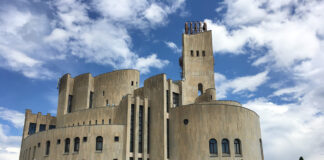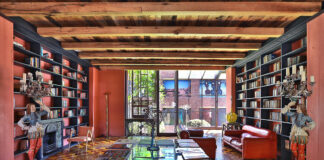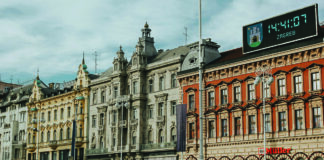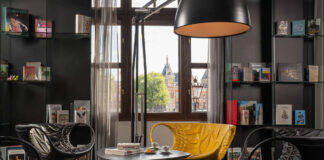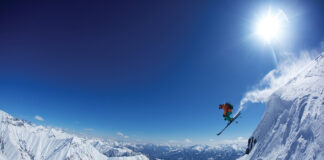DAY 1 – Western Coast and Lagos

9h00 – Visit cape St.Vicent Fortress and Lighthouse, most south western point of mainland Europe. Amazing sunsets here
to see also.
10h00 – Visit Sagres Fortress – Built by the Prince Henry the Navigator in 15th century as a nautical school, to start the
Portuguese Discoveries of Brazil, Africa and the nautical routes to India and Asia, a place of great historical and symbolic
value.
11h00 – Head north along the coast to ALJEZUR and discover the unspoiled beautiful and famous surfing beaches like
Amado, Carrapateira, Arrifana and Odeceixe as well as with washed small villages
Or
11h00 – Head east and visit the historical city of Lagos, inhabited since 2.000 B.C., on the 15th and 16th century’s was the
main port of arrival and departure of the vessels that explored the African coast.
Visit Lagos City Walls, Ponta da Bandeira Fort and church of Santo António and the Museum on the side.
Don’t miss the rock formations of Ponta da Piedade from the top or by boat visiting the caves. Also visit the beautiful
beaches of Porto de Mós, Camilo and Dona Ana.
DAY 2 – Monchique, Silves, Portimão and Lagoa

9h00 – Head to the inland to Monchique Mountain and go to the highest point of the Algarve Fóia peak 902mts., beautiful
view of the west and south coast. In Monchique taste the famous local gastronomy of smoked ham and traditional sausages
and off course the famous “moonshine” beverage the Medronho. As well as the craft shops and pottery.
On the way down the mountain don’t miss out Caldas de Monchique, an amazing thermal spa area used since the times of
the romans which they considered to be “sacred” and cured rheumatism and respiratory problems.
11h30 – Head down to the coast and along the way if are a motorsports fan go the Algarve Motor Park, with a car/bike
racing track including a race driving school with several driving experiences, as well as karting track and off-road track.
11h30 – Head down to the coast and in Portimão visit the nearby fishing village of Alvor and its beautiful beaches and
coastline. Then head to Praia da Rocha one of the main tourist centres of the Algarve Region, you can find good hotels,
restaurants bars and nightlife in this area. Also visit the fortress of St.Catarina built in 1629 has a beautiful view over the
Marina and the Arade River. In downtown Portimão visit the award winning Municipal Museum located on old canned fish
factory and taste the famous Portuguese Grilled Sardines on the restaurants along the riverbank.
14h00 – Cross the old bridge over the river heading east, and visit the beaches of Ferragudo and Carvoeiro with their
colourful fishing boats, the nearby unusual rocks at Algarseco shaped by the wind and the sea, several caves in this area only
are accessible by sea, like the Benagil Cave (Algar of Benagil).
15h00 – In Estômbar village visit the Quinta dos Vales Winery, for a wine tasting, with their excellent wines and the
sculptures spread over the vineyards.
16h00 – Heading further east visit the very small chapel of Nossa Senhora da Rocha, built on the 15th century on a rock
formation that stretches out to the sea.
16h30 – From Lagoa City where you can visit one of the biggest private art gallery in Europe, located on the old Winery
Cooperative site, you can now head north for about 8km to the surrounded by orange trees City of Silves.
Silves was the first capital of the Algarve in 1249 when it was conquered by the 3rd king of Portugal to the Moorish. Silves
was well known already in the 8th century for its development and prosperity, it was a cultural centre with the most brilliant
Moorish poets, chroniclers and jurists. In the city you can visit the red sandstone Castle, the Cathedral both national
monuments and the archaeology museum.
DAY 3 – Albufeira, Loulé , Vilamoura, Quinta do Lago and Vale do Lobo

9h00 – Albufeira, which the name in Arabic means “Castle-on-the-Sea” is regarded today as the “capital” of tourism in
Algarve, a very cosmopolitan city with dozens of hotels, restaurants and a popular nightlife, it tends to be very crowded on
summer time. But it’s a “must go area” with beautiful beaches some forming small coves and bays with rock formations like
Castelo Beach, St. Rafael, St.Eulália and Olhos d’Água with fresh water springs rising in the sand to large golden sandy
beaches with dunes and also to the east the famous Falésia beach with its red cliffs. Craft shops downtown and the nightlife
in Oura beach area are also not to be missed. As well as the fantastic Ocean and wildlife theme park the Zoomarine in Guia.
12h00 – At Loulé, you can also find remains previous to the Arab occupation, the Loulé Castle military architecture is still an
example of those times, inside the castle you can visit the municipal museum with a lot of archaeological artefacts. The
beautiful churches and also the fish and farmers market are also worth visiting.
A day visit to the biggest water slide park in Algarve the AquaShow in Quarteira is also great for the younger ones.
15h00 – Before going to Vilamoura make a small detour to S. Lourenço-Almancil and visit the amazing church all covered
inside with Portuguese tiles.
Vilamoura, is one of the largest Europe’s touristic and real estate developments, in this open leisure complex garden city you
can find besides the several golf courses, cycle tracks, tennis courts, casino, horse riding centre and off course the biggest
Marina in Portugal with luxury boats set among delightful surroundings of outdoor cafes and restaurants and sophisticated
shops. Integrated in its environmental park besides the hundred different species of birds you can also visit the Cerro da Vila
16h00 – Vale do Lobo and Quinta do Lago are amongst the most exclusive resorts in Europe, some world celebrities have
their holiday homes here, high end hotels and properties situated on the middle of golf courses and dense garden touristic
complex. Here is where it starts the Ria Formosa Natural Park and to reach the beach you have to cross a 300mt walking
bridge, one of the longest in Europe.
DAY 3 – Faro, Olhão e São Brás de Alportel

9hoo – Olhão, every weekday but especially on Saturday morning you can’t miss all the fuss at the fish and farmers market,
olhão was in the past a small fishing community, and first stone building the church Nossa Senhora do Rosário was built in
1698 and from that date the settlement developed an urban centre with houses in the style of the Maghreb in North Africa,
that you can still see today. It’s also a good place to catch the ferry’s to the barrier islands with their amazing long sandy
beaches like Armona, Culatra, Fuzeta or Farol.
11h00 – Faro, the administrative capital of the Algarve since 1540, but was already an important city since the Roman times
when it was called Ossonoba and it even had the right to mint coins, you can find roman remains still in the Milreu ruins from
the 1st century A.D., 10km north of Faro. In Faro, you can visit inside the city walls the Cathedral (Sé), that was built in 1249
on top of a Roman Temple and Muslim Mosque , the Convent of Nossa Senhora da Conceição where is located the museum
and outside walls you can go to the church of Nossa Senhora do Carmo with its bones chapel, Algarve’s regional Museum
with a reproduction of a typical Algarve House.
The shops downtown at St. António street and the open air cafés and restaurants that lead to Faro’s small Marina from
where you can catch a ferry to go to the barrier islands that form the Ria Formosa lagoon or just a ½ day tour to see the
wildlife on the lagoon are also worth visiting.
15h00 – S. Brás de Alportel, is municipality located in inland Algarve, very well known for the cork industry, here you can find
several cork transformation plants that you can visit and see all the process as well as cork museum and also the Museum of
the Algarve costume, special delicacies and jams are also traditional form this area. This is where it starts the landscape of
the Algarve known as “Serra” or mountains and from south to north is divided like this 1 .Coastline 2. Barrocal (red farming
land) and Serra (mountains).
Great off-road tracks in this area but also hiking and cycling trails like the Via Algarviana that crosses the Algarve East to
west by the inland
DAY 4 – Tavira, Vila Real Stº António, Castro Marim and Alcoutim
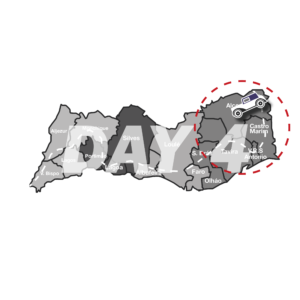
9h00 – Tavira was most probably founded by the Phoenicians, but it was the Romans who left the most significant traces
from the pre-Islamic period on the region example of that is the famous Roman Bridge that crosses the Gilão river
downtown.
Inside the Castle of Tavira, of Arab origin and rebuilt in the 13th Century, there’s a pleasant flower garden where you can
enjoy a view over the city, next to it is the National Monument Santa Maria of the Castle main church built also in the 13th
century on top of where it once stood the Tavira Mosque. Close by is the Convent of Graça built in 1542 and recently
remodeled to host a Pousada (Hotel in a historical Monument). There are dozen other churches in Tavira that also worth the
visit. Catch the ferry to visit the fantastic beaches of Tavira Island or go to small fishing village of Santa Luzia and taste the
famous octopus traditional dishes and catch the ferry to Terra Estreita beach or in alternative by a small train connecting the
resort of Praia D’el Rei to Barril beach where it lies a “graveyard” of anchors. (used in the past to anchor the Tuna catching
net traps)
12h00 –Heading east visit historical center and fortress of the village of Cacela Velha, marvelous view from the Ria Formosa
Natural Park lagoon that here reaches its end after a 60km stretch.
13h00 – Despite existing there a small village, it was not until the 1774 that the city of Vila Real de Santo António was born,
following a political decision to affirm the Portuguese crown in an area desired by Spain. It was built in 2 years following the
architectural fashion at the time, which explains the geometric layout of the streets. The 19th century brought great
prosperity with the canned fish industry and the proximity with Spain, now it’s mainly focused on tourism.
Great place to taste traditional gastronomy focusing on the Tuna Fish and all fish in general,
Big long Sandy beach from Cacela until Vila Real known as the Monte Gordo Bay, great for athletics athletes that come here
on the low season and it’s great for kids in the summer due to its shallow waters on the low tide.
15h00 – Castro Marim, with great strategic importance since the time of the Phoenicians, was at the time surrounded by
water and served as a harbor for boats which sailed up the Guadiana River to collect the copper that was extracted further
north.
In here you can visit the Medieval Castle built in the 13th century and also the São Sebastião Fortress from the 17th Century.
Today, Castro Marim, is also surrounded by salt pans, where is collected the gastronomic delicacy “Salt Flower”, sold up to
10 times the price of normal salt due to its organoleptic characteristics.
17h00 – With records of occupancy since 2500 B.C, Alcoutim was known on those times for the mining industry with easy
access routes of transportation down the Guadiana river. Here you can visit the castle and archaeology museum and
cobbled streets. Try also the local traditional gastronomy that is different form the one on the coastline and also try to swim
in the river beach “Pego Fundo”. The hiking route Via Algarviana starts/finishes here.
Note: This is just an example program with some highlights. Due take the time to explore more.
The informed times may be not accurate. This program can be stretched depending how long you spend in each place
Source: http://www.visitalgarve.pt/pressroom.file.php?fileID=28&file=guiapatrimonio_algarve_en_web_mar2015.pdf
http://www.visitalgarve.pt/pressroom.file.php?fileID=165&file=guia_de_praias_en_web.pdf
http://www.visitalgarve.pt/pressroom.file.php?fileID=27&file=rotas_en_online.pdf
www.algarvepromotion.pt / www.visitalgarve.pt







